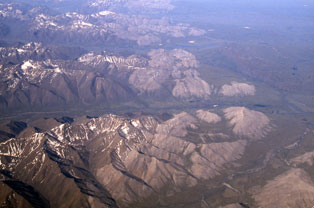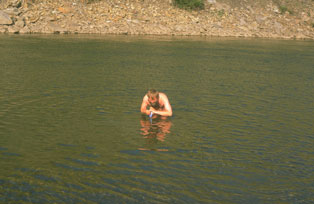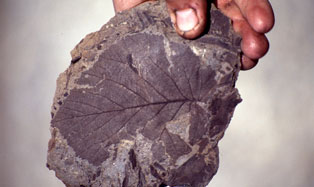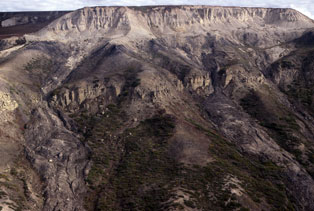About this website
| Background | Navigation | Collections | Photography | Acknowledgements | Authors |
|---|
| Alaska | Russia |
Background - Historical Overview of Relevant Research on the Arctic Slope of Alaska (Northern Alaska Subregion - NASR)At the end of the 19th century the U.S. Army organized the first geographic–geological study of the Brooks Range and northern areas of Alaska under the leadership of H.T. Allen, G.M. Stoney, and V.L. Howard. The U.S. Geological Survey, in particular its division in Alaska, the U.S. Navy and various oil companies continued this research in subsequent years. F.C. Schrader was the first geologist, as part of a topographic survey expedition headed by W.J. Peters, to cross the Brooks Range in order to study the geological structure of the the region north of the mountains. This area is now often referred to as the North, or Arctic, Slope and forms the bulk of the Northern Alaska Subregion (NASR) discussed here. Prior to the Second World War, the geology of the Brooks Range and Northern Alaska was studied by A.G. Maddren, W.C. Mendenhall, E. de K. Leffingwell, J.B. Mertie, P.S. Smith, P. Marshall, I. McK. Reed, and others. L. Lesquereux, W.M. Fontaine, F.H. Knowlton, A. Hollick, and E.W. Brown studied Cretaceous plant remains obtained from the NASR, including those first discovered by H.D. Woolfe in 1884. Collecting plant fossils and determining their stratigraphic significance and geographic distribution were routinely associated with other geological and geographical investigations. In 1923 parts of the NASR were designated as the Navy Petroleum Reserve 4 (NPR-4) and later on the National Petroleum Reserve of Alaska (NPRA); an area subject to extensive oil prospecting between 1944 until 1953. Geologists whose names are associated with this period are G. Gryc, R.M. Chapman, E.H. Lathram, Ch.L. Whittington, M.D. Mangus, W.W. Patton, E.G. Sable, K. Stefansson, W.P. Brosgé, J.T. Dutro, I.L. Tailleur, A.S. Keller, and others. W.P. Brosgé, H.N. Reiser, W.W. Patton, T.P. Miller and their colleagues continued the research for the next two decades, when R.W. Imlay, D.L. Jones, and G. Gryc studied fossil mollusks of the NASR, and R.W. Brown, C.A. Arnold, and J.S. Lowther examined the paleoflora. Results of these investigations have been published in a series of books and in USGS reports (e.g. Collins, 1958a, 1958b; Chapman and Sable, 1960; Detterman et al., 1963; Chapman et al., 1964; Patton and Tailleur, 1964; Brosgé and Whittington, 1966). Charles J. Smiley (or 'Jack' as he preferred to be known) initiated systematic analysis of Cretaceous floras of the NASR. After his first investigations under the supervision of R.L. Langenheim (Langenheim et al., 1960), he focused his efforts on the creation of a phytostratigraphic scheme of Northern Alaska. During fieldwork between 1956–1966, he collected nearly 10,000 plant impressions from 250 localities. Based on these ‘florules’ or assemblages, Smiley proposed a regional stratigraphic scheme that included seven floral zones of the Aptian(?)–Albian to Maastrichtian that were used to subdivide and correlate the plant-bearing deposits (Smiley, 1966, 1967, 1969a, 1969b, 1972a, 1972b, 1974; Scott and Smiley, 1979). The scheme was inadequately substantiated, however: lists of plant taxa characteristic of zonal assemblages were incomplete, many of them were identified at the generic level only, and just a few were figured or described. As a result, the application of the scheme was limited. The next phase of geological research in the NASR followed the discovery in 1968 of a large oil field in the Prudhoe Bay area. Results of comprehensive geological surveys and thematic stratigraphic work, that were carried in the 1970s and 80s, are published in several works (Alhbrandt, 1979; Huffman, 1989; Mull and Adams, 1989) and numerous papers. More recently of particular importance is the work of Mull et al. (2003) who revised the stratigraphic nomenclature of the Cretaceous–Neogene deposits in Northern Alaska and verified ranges and distribution areas of respective stratigraphic subdivisions, taking into account all the data on their lithology, thickness, and age known at that time. Between 1977 and 1991, R.A. Spicer in collaboration with J.T. Parrish, W. J. Lewis, and H.F. Shorn carried out fieldwork in Northern Alaska aimed at investigating the Cretaceous–Early Paleogene floras in that subregion; fossil spores and pollen were simultaneously studied by W. J. Lewis, P.R. Grant and N.O. Frederiksen and their colleagues. Spicer presented the results obtained in a USGS Contract Report (Spicer, 1983) and in a series of papers (some in co-authorship with colleagues) dedicated to Alaskan Cretaceous and Paleogene floras and paleoclimate, fossil wood and dinosaur remains, and the correlation of concurrent floral assemblages established in Alaska and North-eastern Russia. Spicer and his co-authors described floral assemblages from the lower and upper parts of the Killik Tongue in the Umiat-Chandler area, from the Niakogon, Tuluvak and Kogosukruk tongues of the same area, and from the Sagwon Member of the Sagavanirktok area. R.A. Spicer and A.B. Herman (summer of 1996), and then R.A. Spicer and A.J. Spicer (summer of 1998) studied Cretaceous deposits in the western NASR (basins of the Kukpowruk and Kokolik rivers) and collected their diverse plant remains (approx. 60 species), which were described and illustrated in two papers (Spicer and Herman, 2001; Herman and Spicer, 2002). In 1997–1998, Herman and Spicer jointly re-examined and photographed plant fossils from the collection of Smiley stored at the Smithsonian Institution, Washington, DC. Later on, during the 2001 and 2005 field seasons, R.A. Spicer, A. Ahlberg, D. Jolley, M.G. Moiseeva and A.B. Herman studied Paleocene deposits in the eastern NASR, where representative assemblages of fossil plants were collected and compared with Russian material (Herman et al., 2004; Herman and Moiseeva, 2006; Moiseeva et al., 2009; Spicer et al., 2009; Daly et al., 2011a & b). Recently a Cenomanian liverwort was described from Kuk and Kaolak rivers in Northern Alaska (Heinrichs et al., 2011). For over a century the Cretaceous and lower Paleogene deposits of the Alaskan subregion have been studied in detail in terms of their lithology, sedimentology, and biostratigraphy. While the marine fauna, primarily inoceramids, ammonites, and foraminifers, has been comprehensively studied the diverse Cretaceous–Paleocene flora of the NASR has so far not been described in anything like its entirety. The phytostratigraphic scheme by Smiley, which is based on preliminary and incomplete investigation of fossil plants, turned out to be difficult to apply in practice due to lack of appropriate illustrations. Published data on separate taphofloras of the NASR were also best described as 'preliminary', especially those, which include a hundred of taxa and more, being characterized by lists of a few genera and single species in respective publications. The phytostratigraphic scheme suggested in this work for the Albian–Paleocene of the NASR is based on an ongoing revision of fossil floral collections referred to above, and detailed comparisons of floras on both sides of the Bering Straits. |
 |
|
 |
||
 |
||
 |
||
 |
||
 |
||
 |
||
 |
